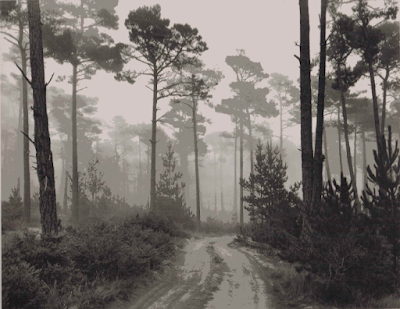Ansel Adams (1902 - 1984) is considered by many to be America's greatest landscape photographer. He was influenced by Paul Strand which gave rise to an interest in 'pure' photography. His photographs are characterised by use of a small aperture to give pin point clear images with a great depth of field.He was also knowledgeable on the science of photography, creating in 1941 the 'zone system' which was an aid to determine correct exposure and development times.
He is most famous for his photographs of the beauty of his native North America but was also a keen photographer of trees, often producing striking black and white images.
The images I show below are copied from:
Ansel Adams. Trees. The Trustees of the Ansel Adams Publishing Rights Trust. 2004. Little Brown and Company, New York. ISBN 0-8212-7752-9
Page 9.
Aspens, Northern New Mexico. 1958.
This photograph was taken “on a crisp autumn day in the mountains north of Santa Fe ... We were in the shadow of the mountains, the light was cool and quiet and no wind was stirring. The aspen trunks were slightly greenish and the leaves were a vibrant yellow. The forest floor was covered with a tangle of russet shrubs. It was very quiet and visually soft ... I visualised the images as stronger, in accord with the mood of the hour and the place.” (Ansel Adams, from ‘Examples: The Making of 40 Photographs’.)
Page 97
Aspens, Dawn, Delores River Canyon, Colorado. 1937
Page 13
Road and Fog, Del Monte Forest, Pebble Beach, California. 1964
The common denominator for me of all these images is the sheer vertical uprightness of all these trees. I suspect the maximum lean is 5 degrees. Add this to the use of black and white gives a solidity and strength to all the images.
The 3 images are tremendously varied. On Page 9 the softness of the shrub is shown not only by the presence of leaves highlighted dramatically in the light but the contrasting 'round' shape. The visual tone is immense from the near black of the forest to the almost white of the leaves. When you read Adams' comments you realise that he has enhanced thisphotograph to create an image more in keeping with moonlight and nighttime. An image of power.
The second image on Page 97 appears softer to me. The dawn light has caught most of the aspens, although hints of more can be seen in the background. The trees draw you in to the forest - they do not appear harsh or threatening. This effect is because of the bright dawn sunlight - probably 30 minutes later and the image would be flatter as more trees were illuminated, possibly with a background.
The third image in the fog is softer again. The image is more 'open'; the track leads you into the image to see what is beyond the bend. The fog adds a softness which bright sunlight could not although the image is far from dark, and totally non-threatening. The obscurity caused by the effect leaves you questioning - what is down the track, amongst and beyond those trees.
In order for the images to work in black and white they must have sharp lines and shapes - which is certainly the case. However Adams' great strengt is his use of light to evoke mood.
I am also showing an image of my own, taken on an autumn afternoon.
f/16; ISO 200; 1/80 second; focal length 40 mm
How does my image compare? Well there are many differences:
fewer trees
less upright with deeper angles
colour not black and white
closer
more cluttered
However I believe the influence can be seen. Certainly after seeing such images by Adams I became more aware of trees as shapes - especially vertical lines. Possibly a wider lens may improve the image by including the tree tops (my wide angle lens is currently faulty); possibly I could shoot from a lower perspective to give a greater impression of height. The garden itself limits the distance from which I can shoot any image. The light is harsher than that used by Adams, and yet the gradations of colour from near violet to blue within the sky gives a beauty of its own.
Technically a lower ISO (100) and smaller aperture (f/22) to maximise depth of field would also improve the image. The use of a tripod to enable use of the slowest possible shutter speed might have enabled this.
This image is not the finished article, but gives a direction in which to travel.




No comments:
Post a Comment